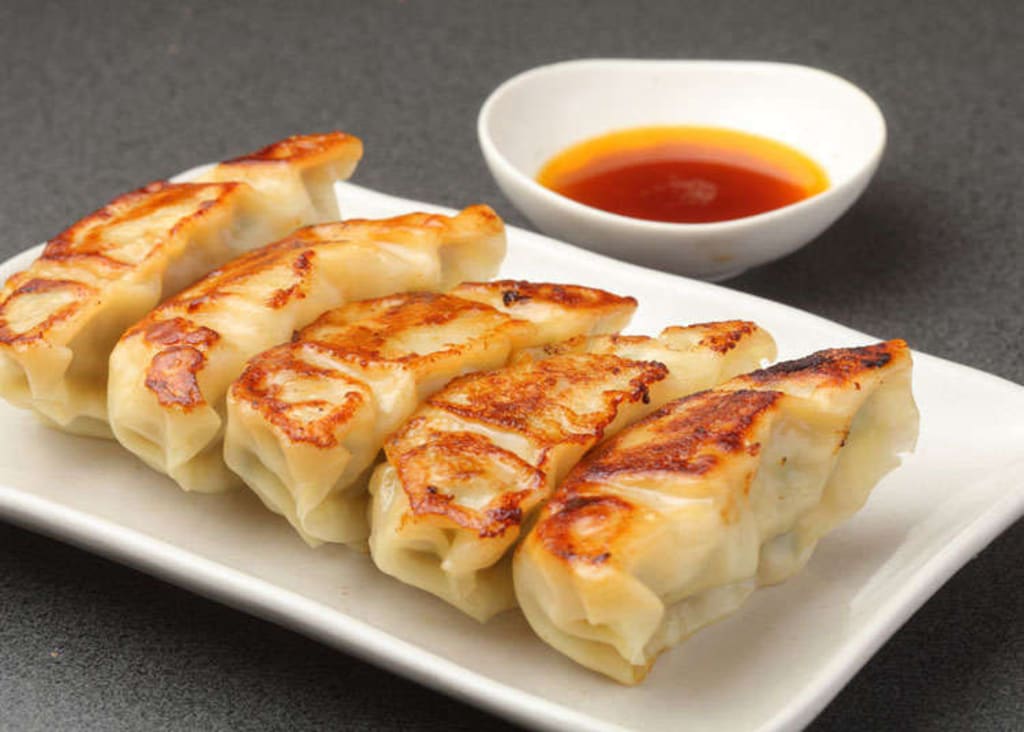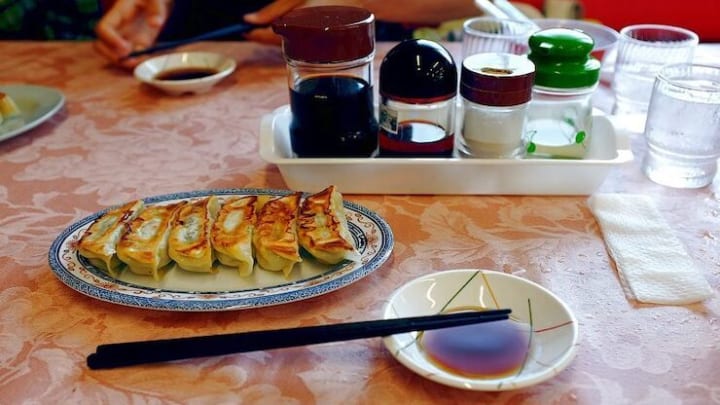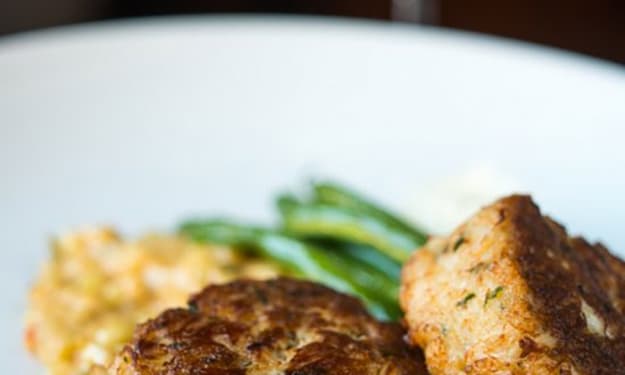
In my lifetime I've been blessed with the ability to travel the world and to experience the many different foods and cultures the world has to offer. Whenever I'm pressed to name my favorite food, I always respond with it depends. I've dined on beef wellington and champaign prepared by a world-renowned French chef in the back corner of a busy 5-star French restaurant on New Year's Eve, all because the airline had delayed our trip and the travel agent had messed up our itinerary on a trip to Paris with my wife and youngest son. We had a choice of spending New Year's Eve in our rented car but a man took pity on us. How were we to know he owned one of the most famous restaurants in all of France. That's for another story though. Given time to think about it, my favorite foods have always been finger foods. Those meals don't take much time to prepare and can be varied for different tastes. Most importantly, I prefer foods that I can make at home.
This is why I've chosen yaki gyoza to write about. Not just any old potsticker. I want to tell you about the yaki gyoza. For me, it's special. When folks think of gyoza or potstickers in general, they think of a mushy doughy tasting dumpling filled with leftover meats and vegetables. That sounds disgusting to me. If that's what you're expecting here, you've come to the wrong article. Gyoza has been around for a very long time, some believe for thousands of years. There are many versions of it and most people agree it originated in China. My experiences with it began in the late 1970s as a young traveler in Japan. I had been assigned to a little village called Iwakuni which is located on the southern tip of Japan's main island, Honshu in the Yamaguchi Prefecture. Iwakuni is known for many things among them, it is home to a large American military installation. It is also home to the infamous Iwakuni Castle and the Kintai Bridge. This bridge was built in the manner of the old ways and is comprised of five arches that span the Nishiki River. There are many museums in the area celebrating the samurai way of life which was well-established in Iwakuni.
Any visitor to Iwakuni should feel immediately safe. Crime is almost non-existent and there are plenty of welcome centers that welcome visitors from all over the world. Except for the annual cherry blossom festival that happens every spring, the crows are minimal so anyone planning a visit here shouldn't have a problem locating a place to stay. Most of the sites worth seeing in Iwakuni are located along the Nishiki River which has several public accesses for swimming, picnicking, and wading. Traditional Japanese food is readily available as well as international menus. There is no reason for anyone to go hungry in Iwakuni.
Gyoza is a popular appetizer or a complete meal when served with a salad or other dish. I prefer the yaki gyoza which is a pan-fried style. This leaves the dumpling part of the gyoza crisp and slightly brown giving an ideal crunch to the bite. I've had yaki gyoza stuffed with all vegetables ranging from peas and carrots to pork to ground beef. Personally, I prefer the pork yaki gyoza with a special sauce. To be fair, I've also tried gyoza stuffed with mushrooms, shrimp, or cheese but I didn't like those as much. Let's take a peek at one of my favorite recipes.
Pan-Fried Pork Yaki Gyoza

Equipment
If you plan to do this a lot, you can invest in a professional gyoza cooker, but be prepared to spend $$$. Otherwise, if you're like the rest of us, the next best option is a 7 or 9 inch cast iron skillet with a glass lid that fits. I also recommend a good set of cooking chopsticks, but again, anything that allows you to safely pick up hot food from a hot skillet will suffice.
Ingredients
Ingredients are divided into two categories: wrappers and stuffing.
Wrappers
The wrappers can be store-bought or hand-made. You can purchase them from most specialty food stores that offer oriental cuisine. I would avoid using the wrappers used for wontons and Japanese burritos since they tend to be thicker, chewier, and made for larger foods. Look for the wrappers specifically labeled for gyoza or for potstickers. They will be smaller in size and much thinner. They are sold as a frozen product so you will need to allow time to defrost them before using them and once you defrost them, you'll have to refrigerate them. They cannot be refrozen.
Another alternative is to make your own. If you decide to make your own, you'll need all-purpose flour, water, sesame seed oil, and salt. The average size of a yaki gyoza wrapper is a 4-inch circle that is roughly 0.05 inches thick.
Stuffing
Before we discuss the types and quantities of stuffing, I want to emphasize the importance of chopping and grinding your stuffing into a finer than normal cut. Yaki gyoza are small in size, therefore you want the fillers to be smaller too. There is nothing worse than biting into a yaki gyoza and being overwhelmed with the taste of only one ingredient. For this recipe, we will use ground pork, finely chopped cabbage, minced ginger, salt, sake, minced garlic, sesame oil, soy sauce, and minced chives.
Quantities (This recipe will make 5 servings of 6 yaki gyoza each)
- 1 cup of finely minced pork
- 2 cups of finely chopped cabbage
- 1/4 cup of minced spring onion
- 1/2 teaspoon of grated ginger
- 1 tsp of minced garlic
- 1 tsp of sake or white wine
- 1 tsp of soy sauce
- 1 tsp of salt
- 1 tsp of vegetable oil
If you plan to buy your wrappers, you'll need about 30 wrappers. If you plan to make your own, you'll need the following ingredients:
- 1 cup of all-purpose flour
- 1/3 cup of boiling hot water
- 1 pinch of salt
- 1 tbsp sesame seed oil
Instructions
You can make the stuffing or filler first or you can make the wrappers first. The choice is yours. I prefer to make the filler first since I can refrigerate it. You can always refrigerate the wrappers too, but I prefer to go ahead and stuff the gyoza as soon as the wrappers are ready since they are easier to handle when they are fresh.
I'm going to make a big assumption here and presume you already know how to mince, chop, and grate so when I say you'll need finely chopped cabbage, you will have already finely chopped the cabbage. If not, go back to the ingredient list and make sure each of the items you have are already minced, chopped, and grated before proceeding. It will save you a tremendous amount of time going forward.
Mix the minced pork, chopped cabbage, spring onion, ginger, garlic, soy sauce, sake, sesame oil, and salt into a mixing bowl. Using your hands and/or a spoon, mix these ingredients thoroughly so they are well combined. The finished texture should be sticky. This is raw pork so do not be tempted to taste and make sure you wash your hands before proceeding to the next step. Place this mixture in your refrigerator.
If you have purchased your wrappers, skip this step. If not, mix the all-purpose flour and boiling hot water into a mixing bowl. Use chopsticks or another utensil to mix the combination into a crumble-like texture. Add the sesame seed oil and continue to stir and mix. As the mixture cools, use your hands to thoroughly mix everything together into a ball. Wrap the ball in a plastic cling wrap and let it rest or continue to rise for 1/2 hour.
After 30 minutes, remove the cling wrap and continue kneading the dough atop a floured workboard. Knead the dough until it is completely smooth. Cover it with cling wrap again and let it continue to rise for another 30 minutes. When complete, divide the dough into 2 equal parts and roll out each part with a rolling pin until both parts are roughly 0.05 inches thick. Using a 4" cookie cutter, cut out your 30 wrappers. You can combine any waste and roll again to make additional wrappers if needed.
The Fun Part
Remove the filler from the refrigerator and spoon 1 tbsp of the filler onto a wrapper. Fold the wrapper over covering the filler and using your thumbs and fingers, crimp both sides of the wrapper together so the filler stays inside.
Warm up your cast iron skillet and drop some vegetable oil (not much) into the bottom of the skillet. Then place as many of the yaki gyoza as will fit into the skillet. Use medium heat and brown the bottom of the gyoza. Once the bottoms are slightly browned, I recommend pouring some hot water, maybe 1/4 cup, into the skillet and then covering the skillet with the glass top. This will steam fry the yaki gyoza. You'll need to crank the heat up from medium to high and you'll want to steam fry them for about 3 minutes to make sure the pork is thoroughly and evenly cooked.
Remove the lid and let the remaining water cook off. Pour about a 1/4 cup of sesame seed oil around the yaki gyoza. This will crispen the bottoms and turn them a golden brown.
Presentation
I recommend serving the yaki gyoza on a white plate with the brown side up. You can add a serving of steamed white rice as a side dish for a complete meal. Some folks prefer to use a simple soy sauce for dipping the yaki gyoza. Others will add chili oil to their soy sauce. I'm from Texas and I have found that barbecue sauces, steak sauces, even a mustard-based sauce all enhance the taste of yaki gyoza. However, nothing makes it taste better than chasing it with good sake or an ice-cold beer.
This post is part of the Vocal Cooks Collaborative. Click here for an index of all story-recipes. Previous posts in this series include:
https://vocal.media/feast/two-pots-to-happiness by Arpad Nagy!
About the Creator
Joey Lowe
Just an old disabled dude living in Northeast Texas. In my youth, I wanted to change the world. Now I just write about things. More about me is available at www.loweco.com including what I'm currently writing about or you can tweet me.






Comments
There are no comments for this story
Be the first to respond and start the conversation.